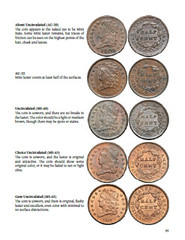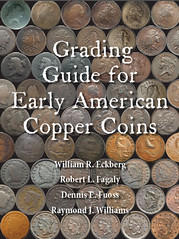
PREV ARTICLE
NEXT ARTICLE
FULL ISSUE
PREV FULL ISSUE
NEW BOOK: GRADING GUIDE FOR EARLY AMERICAN COPPER COINS
Co-author Bill Eckberg forwarded this announcement of the long-awaited EAC Grading Guide For Early American Copper Coins. Thanks, and congratulations to EAC and the authors for completing this important undertaking!
-Editor
The cover price will be $54.95 plus $5 P&H. EAC or C4 members in good standing will get a $5 discount. Members purchasing the book at the EAC convention will pay only $45. All proceeds from the book will go to EAC to support its educational and outreach activities. Because copper coins were the money of the people and (unlike gold coins) were heavily used in commerce, because they are heavy and soft, and because copper is more reactive to oxidation than silver or gold, they received more wear and damage than early gold and silver coins. Because their relative value did not fluctuate like that of gold and silver coins, they were less subject to mass meltings during their time of circulation. Thus, many stayed in circulation until they were unrecognizable due to wear or corrosion. Yet, because these coins were the money of the fledgling United States, and because the insults that plagued them add to their charm, the collectors of early copper are among the most dedicated and involved in all of numismatics. Nevertheless, the different grading standards early copper specialists use from the commercial standards in the rest of US numismatics, and the different way they account for damage to coins from that used by the rest of numismatics adds an extra level of complexity and concern for those who might wish to collect these endlessly fascinating coins. This book addresses that complexity and concern by thoroughly describing the grading standards and processes used by specialists in the field and comparing them to the commercial standards and processes used in the rest of numismatics, with the goal of making copper collecting easier, more enjoyable and more fulfilling for all. Grades from About Good to Mint State (and higher Mint State grades, where such coins exist) of nearly all series are illustrated by full color photos twice the diameter of the coin. Most of the images have been taken, with permission, from the auction lot archives of Ira and Larry Goldberg, Auctioneers, Heritage Auctions and Stacks-Bowers Galleries. The book addresses each of the different types of half cents and large cents individually. Earlier grading guides have lumped together several half cent and large cent head styles with substantially different wear patterns, causing confusion that this guide avoids. Liberty Cap half cent and cent grading standards are illustrated and discussed by date, as are two distinct head styles each of Chain, Draped Bust and Braided Hair cents, and four head styles of Coronet cents. Of particular importance, there is an illustrated explanation of the differences between the traditional technical sharpness standards used in EAC and those used commercially. No other guide provides as much information about grading the Confederation era coinages. A chapter is devoted to standards for grading Confederation era state copper coins (Connecticut, Vermont and New Jersey coppers and Massachusetts cents and half cents) and Fugio cents. In addition, about 20 pages are devoted to fully explaining and clearly describing the unique and supposedly mysterious process of “net grading” used by specialists to account for post-striking damage in determining a grade. Since defects impact the grade of higher-grade coins more severely, net grading is described for each sharpness grade from Good to Mint State. Large color photos identify the defects that lead to the net grade.


Its chapters also directly address the history of the grading of early coppers, the differences between technical and market grading, authentication, the handling and preservation of early coppers, and factors other than grade that affect value. EAC members have discussed producing such a guide ever since the second meeting of the club in 1969, so it can be said that this book has been 45 years in the making. The authors have worked for two years to produce it. For anyone with an interest in the first coins of the United States, and especially for anyone who wants to learn to grade these coins as well as a professional, and thereby find the greatest possible value in early copper coins, this book is indispensable. An order form can be downloaded at: http://eacs.org/Book%20Invoice.pdf A full-page ad can be downloaded at: http://eacs.org/Grading%20Guide%20ad.pdf For additional information including ordering for resale, please contact halfcent@mac.com.
Bim Gander, President, Early American Coppers One might legitimately ask why a coin club like EAC needs its own grading standards. On the surface, the very idea smacks of exclusivity, like some fraternal handshake to be shared only by the snobbish brethren of some secret society... The question is eloquently answered in this superb new book by Messrs. Eckberg, Fagaly, Fuoss, and Williams. To be sure, EAC grading has been around for a long time, but the concept of net grading has likely been applied in as many ways as there are members of the club. A major contribution of this volume is that it provides standardization with color photography and the judicious selection of those coins which best illustrate the technical EAC grades for every early copper design. Even more important are the dozens of photographs of where EAC damage evaluation is applied: the essence of “net grading.” Without a doubt, the ability to evaluate a coin’s post-production damage, and its impact on value, is an essential skill for all collectors. It is especially important for the connoisseurs of our early copper denominations, where even some low grade examples are highly prized. Denis Loring, large cent expert and charter member of EAC “At last! The mystery of EAC grading, that arcane process used by alleged “copper weenies” and the dealers who love them, is finally revealed. This comprehensive, profusely illustrated guide presents the what, the why, and – most important – the how of EAC grading, detailed by type, date and even die variety. Of particular interest is a textual and pictorial comparison with grading by PCGS and NGC. This long-awaited book is immediately an indispensable reference for anyone interested in the early copper coins of the United States.” J. R. (Bob) Grellman, Jr. , cataloguer of copper coins for Ira and Larry Goldberg, Auctioneers Where was this book when I needed it over 50 years ago? It would have saved me from so many bad decisions when buying early coppers. While no book alone can be an adequate substitute for experience, the authors have done a remarkable job simplifying the very complicated subject of “EAC Grading.” Grading disagreements will not disappear, of course, but at least this book can help focus our thinking on the matter. I am proud to have been a part of this landmark project. Mark Borckardt, Senior Cataloguer, Heritage Auctioneers and Galleries Since joining Early American Coppers (EAC) 40 years ago, I have developed a thorough understanding of early copper grading. Today, I provide all of the EAC style grades for half cents and large cents that appear in my company’s auctions. However, when asked to explain how I arrive at those grades, I am unable to comply. The topic is that complex. The authors of the Grading Guide for Early American Copper Coins have accomplished what I never could. They explain EAC style grading for half cents and large cents, and even include Colonial coins. Not only do they explain EAC style grading, they teach the reader how to grade by those standards. Every early copper collector needs to understand EAC grading. Every early copper collector needs this book. Q. David Bowers, Chairman Emeritus, Stacks-Bowers Galleries I have been following the evolution of EAC grading for many years. I congratulate the authors for their discussion of issues such as luster, porosity, and the importance of various defects at various grade levels. Taken together, these considerations yield an EAC grade that represents old-time conservatism and tradition. Put another way, I can bank on an EAC EF-40, for example, being a very nice EF-40, whereas a commercially-graded EF-40 can range anywhere from desirable, to a coin I would never want to own. Beyond that, the authors – and the leaders of EAC – are to be commended for encouraging their members to study their coins carefully, which adds greatly to the pleasure of ownership. James L. Halperin, Co-Founder of Heritage Auctions and author of How to Grade U.S. Coins An insightful and incredibly useful guide for anyone who wants to learn how to grade copper coinage like a specialist. It’s about time that someone finally wrote this book. Impressive! EMPLOYMENT OPPORTUNITY!Live and Work in Southern CaliforniaStack’s Bowers Galleries offers an important employment opportunity for the right person. We are seeking an experienced numismatist in the American series—coins, tokens, medals, and paper money—to work with our “dream team” of catalogers, building on the tradition of the Ford, Eliasberg, Bass, Cardinal, Norweb, Battle Born and other great collections. If you can write in an authoritative and compelling manner with a high degree of accuracy, this may be just right for you! You will be working in Irvine, a modern community in dynamic Orange County, California—one of the finest areas to live. We offer generous benefits including medical and dental coverage, 401K plan, and more. Our offices are in our own modern, state-of-the art building with all amenities. If you would like to be considered for this position please contact Q. David Bowers by mail or by email with your resumé, samples of your past writing (on numismatics or other subjects), and salary requirements: Mail to the attention of Q. David Bowers, PO Box 1804, Wolfeboro, NH 03894. Email to: Ckarstedt@stacksbowers.com Wayne Homren, Editor The Numismatic Bibliomania Society is a non-profit organization promoting numismatic literature. See our web site at coinbooks.org. To submit items for publication in The E-Sylum, write to the Editor at this address: whomren@gmail.com To subscribe go to: https://my.binhost.com/lists/listinfo/esylum All Rights Reserved. NBS Home Page Contact the NBS webmaster 
|
